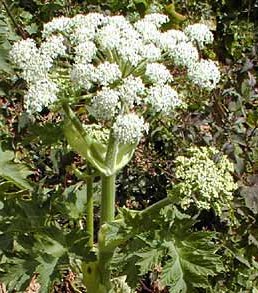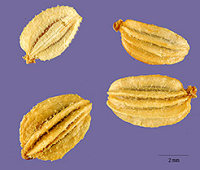Angelica Characteristics
(Archangelica officinalis)

Name Origin:
The name Angelica derives from its connection to angels including Michael the Archangel. Read more on the History of Angelica.
Natural Order:
Umbelliferæ
Growing Cycle:
Biennial or Perennial Herb
Origins:
Believed to be a native of Syria and has since spread to many cool European climates becoming naturalized in Lapland and the Alps
Height:
4 – 6 feet tall
Branch Length:
Frequently 3 feet in length
Characteristics:
New growth has red stems and green foliage
Angelica Flowers:
White (most common), yellowish or greenish in color, small and numerous, displayed in large roundish umbels
Growing Angelica
(Seeds, sowing, transplantation, propagation and harvesting)
Sowing Angelica Seeds.

Growing angelica from seeds is possible but the seeds must be fresh. Opinions vary if seed life is 2 years or only one – better to get the freshest possible seeds to ensure the highest possible germination rates. Plant angelica seeds standing on their edge to help keep them from rotting. Angelica seeds germinate best when they are fresh. Some sources caution that store bought seeds are often unable to germinate. It is best to purchase growing angelica plants, harvest your own seeds and plant them immediately. The larger the seed, the more likely it will germinate.
Sow the seeds in the autumn, as they will need the cold to germinate, where you wish to have the plants permanently reside or in a nursery bed. Seeds should be planted half an inch deep to ensure the seeds are covered. Keep the soil loose and open as long as tools can be used among the plants. Once your angelica plants are established enough to shade the ground well, they may be left to care for themselves.
Don’t miss our Angelica Companion Planting Guide to explore companion planting with angelica.
Transplantation of Angelica Plants.
Our sources disagree a bit here. The older materials provide the following advice: Transplant your angelica seedlings when still small with a space of about 18 inches between each plant. If not already in their permanent location, transplant your angelica plants in the autumn 3 feet apart.
A modern resource explains that with it’s long taproot, Angelica can be quite temperamental if transplanted and recommends not covering the seeds.
A safe bet would probably be to assume that transplanting angelica plants might be risky and to make sure that you don’t damage the taproot.
Angelica Propagation.
Plants may not produce seed until the second growing season. Be vigilant in seed gathering otherwise your garden may become overrun with Angelica seedlings the following spring. Once allowed to produce seeds (typically the second year), most Angelica plants will die. Cutting the flower heads and preventing the formation of seeds will allow the plants to live for several additional years.
Harvesting Angelica.
Harvest stems in April or May; leaves in May or June, before flowering; and the roots should be gathered late fall.
Culinary Uses of Angelica
(stems and leaf stalks, leaves, seeds, Angelica oil, candied Angelica)
The Angelica plant is one in which virtually the entire plant can be used in the kitchen for cooking.
Angelica Stems & Leaf Stalks in Cooking
While still succulent (before seasonal die-back), the foliage can be used as salad greens or roasted or boiled like potatoes. Angelica stems can also be blanched like celery.
Leaves.
Tender Angelica leaves can be boiled and are similar to spinach. They are also used as a garnish for meat and fish.
Angelica Seeds in Cooking
Angelica seeds are aromatic and bitterish; they are used to flavor beverages, cakes, candies, and comfits.
Aromatic Angelica Oil.
Used for flavoring and obtained from the seeds and sometimes the roots through distillation. Oil obtained from Angelica root yields about one pound of oil from 200 pounds of root.
Candied Angelica.
Made from fresh roots, tender stems, leaf stalks and the midribs of the leaves. (Fresh angelica roots, in their original form, are not edible.)
Additional Angelica Information.
Be sure to visit our article on the History of Angelica to learn why this herb was once called the “Root of the Holy Ghost” and how it was used throughout history.
Anyone interested in growing angelica should take a moment to check out our Angelica Companion Planting Guide to learn what other herb should never be planted with angelica as well as which plants grow well with angelica.
The Chinese have been growing Angelica sinensis for its medicinal properties for over 4,000 years. Modern, western medicine offers both contradictory and conflicting advice on this medicinal herb in the angelica genus.
